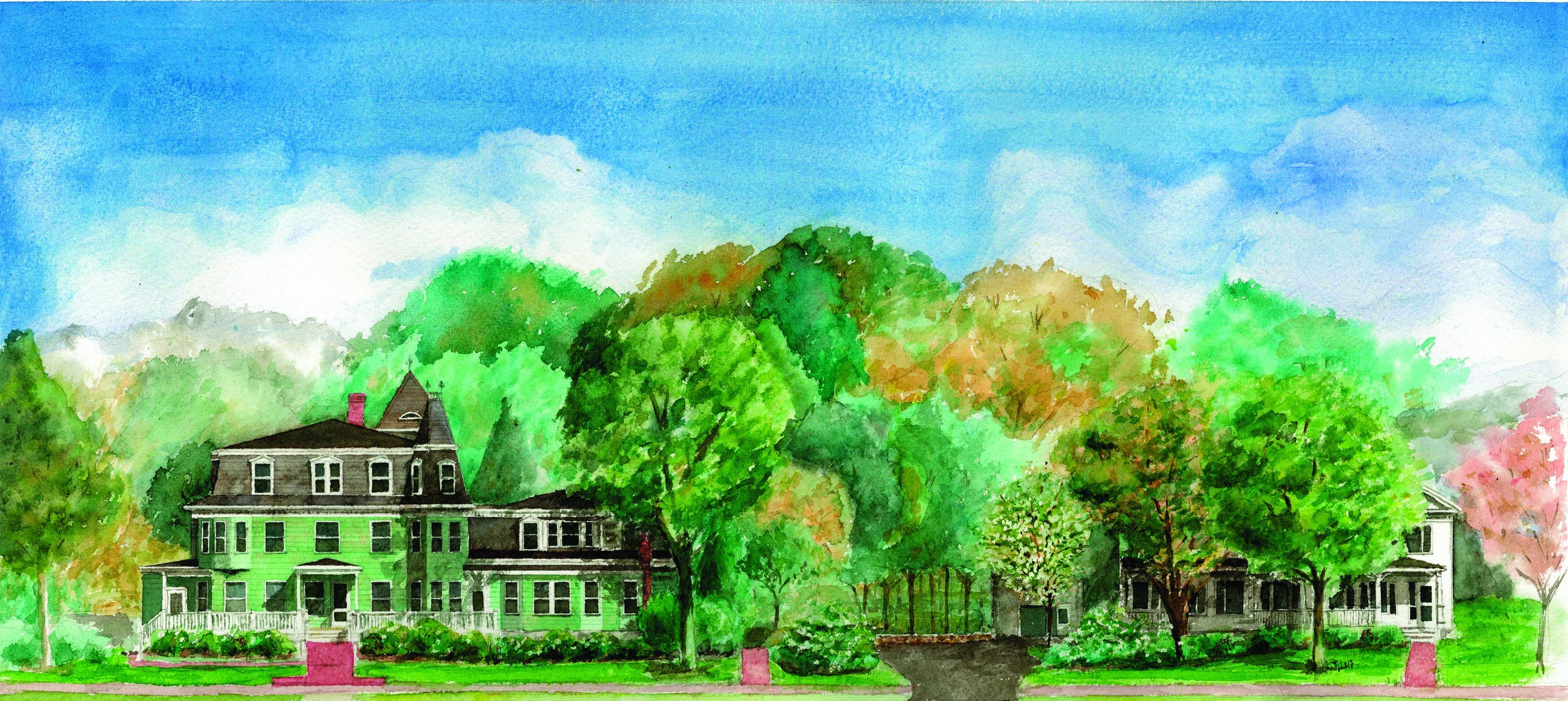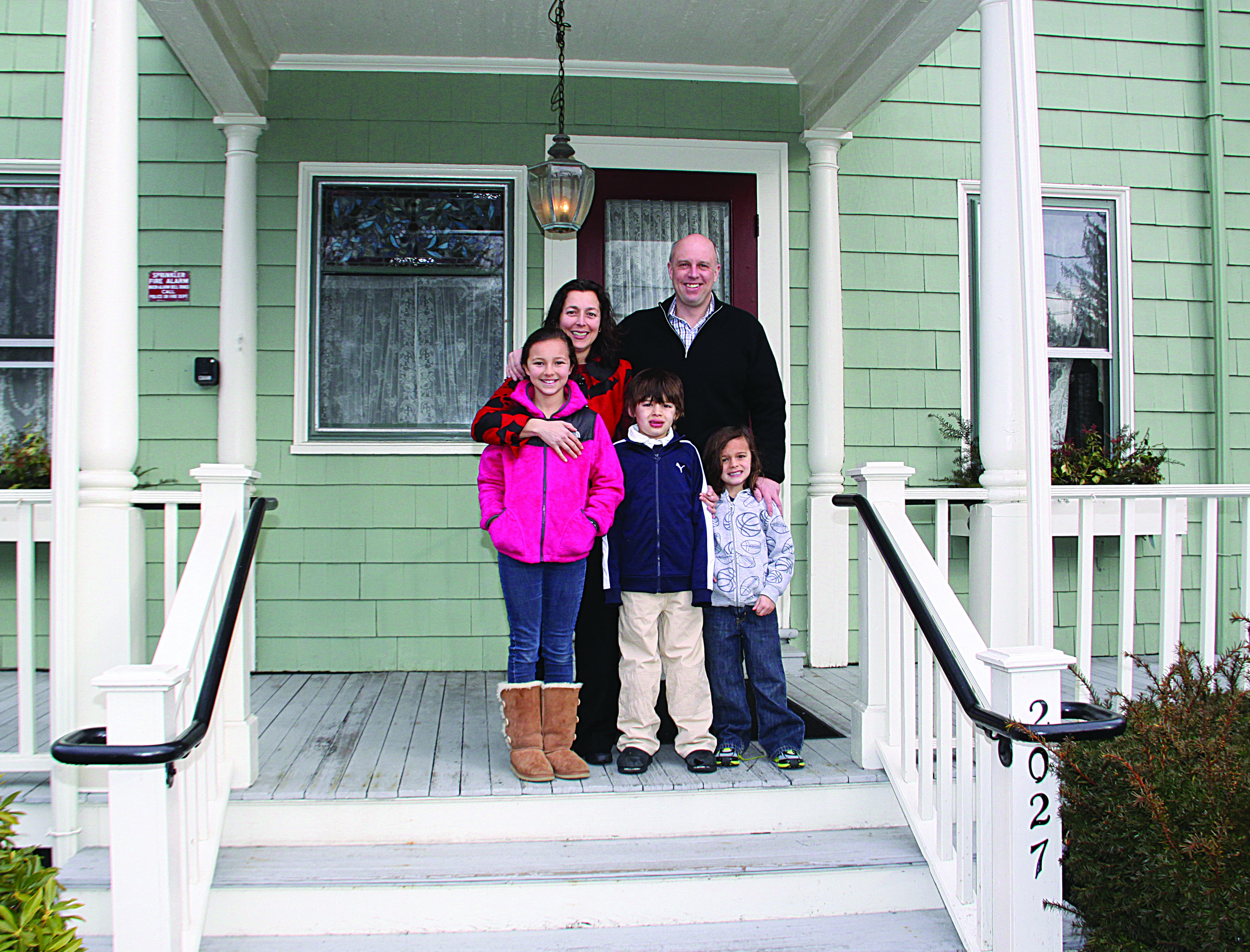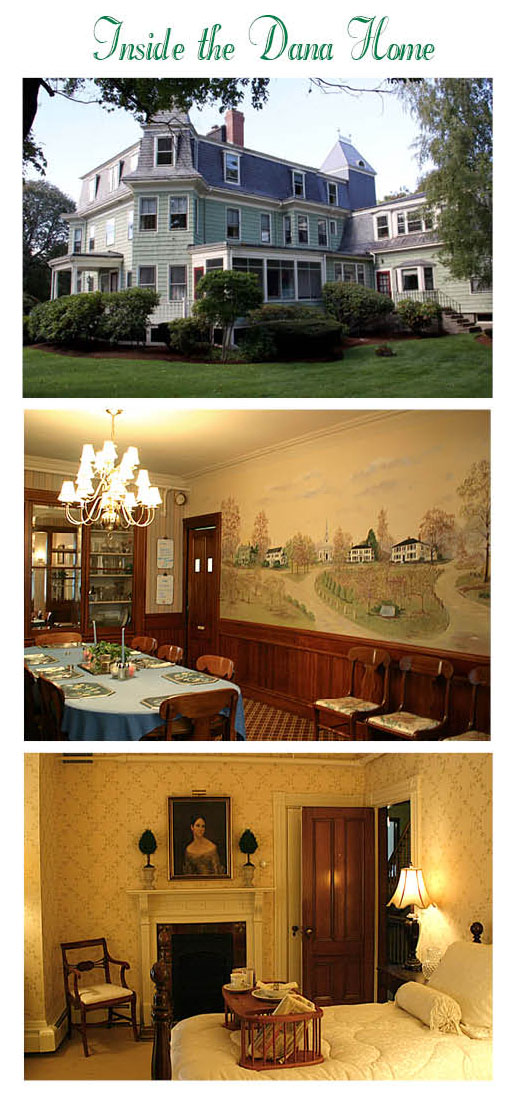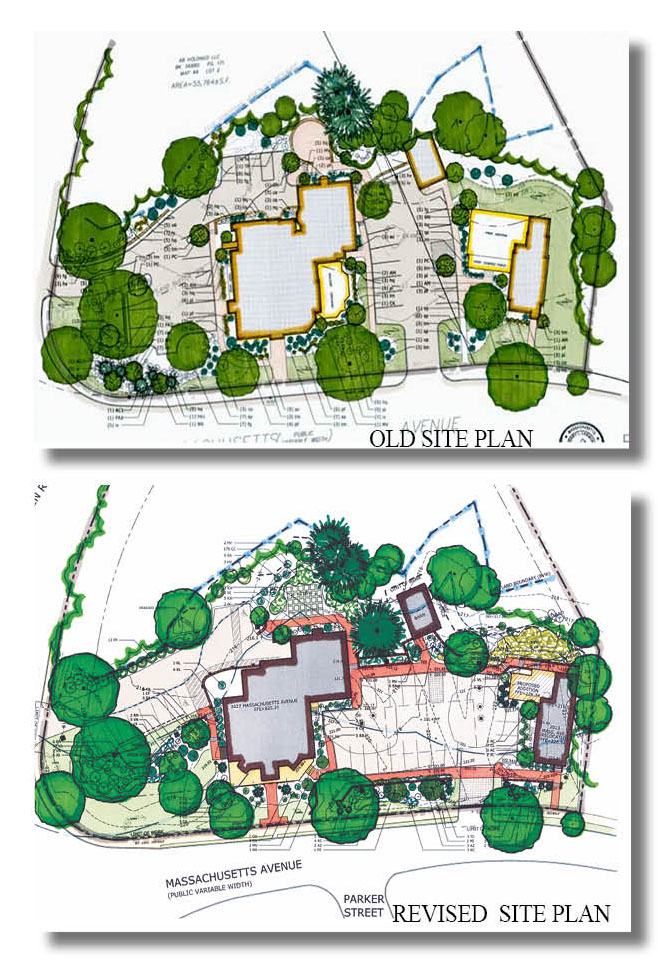Lexington Family Opens a Traditional New England Inn


Lexington has a long history of providing hospitality to visitors. In his volume Lexington Massachusetts, Treasures from the Historic Archives, Dick Kollen, Lexington historian and former Lexington High School teacher writes, “In the nineteenth century several large and successful hotels prospered near the center of town. The heyday of Lexington’s hotel era really began after the civil war, when the railroad’s full effect of affording easy access to Boston combined with increased urbanization. Large Hotels such as Massachusetts House and Russell House attracted travelers who liked to ‘summer’ in Lexington as well as those planning winter sleighing parties.”
The Lexington House (originally called Muzzey’s Hotel) was built by Benjamin Muzzey in 1847 where the CVS stands today. It took the place of the Monument House a smaller hotel owned by Muzzey just as the railroad (he was a big booster and a heavy investor in the railroad enterprise) came to town. Kollen writes that Lexington House was an important part of the community providing a venue for reunions, concerts and other community gatherings. It was an elegant building with “two extended wings, fronted by large porches.” The “Bill of Fare” at the Lexington House restaurant featured such delicacies as “Escalloped oysters, quail, duck and Italian cream.”
After this period, hotels in Lexington began to disappear until the Battle Green Inn remained the only lodging option in Lexington proper. The Battle Green, was allowed to fall into such general disrepair that it could not be credibly marketed to families and tourists as an inn so it became transitional housing and was subsequently demolished. It is now the site of luxury condominiums. Lexington has no centrally located accommodation for visitors.
Currently a proposal is before the Lexington Planning Board and headed to Town Meeting to allow the rezoning of the former Dana Home property to accommodate an inn and modest restaurant just outside the central business district. The Dana home is located at 2027 Massachusetts Avenue and has been used as an elder home for 95 years since it was purchased with a generous bequest from Lexington resident Ellen Dana. The Dana Home is perfectly suited to use as an inn with rooms with private baths, a modern sprinkler system, commercial-grade kitchen and hospital-sized elevator for handicapped accessibility, the property will transition nicely. This may be Lexington’s chance to continue an historic tradition of warm, welcoming hospitality in the town center.
Lexington Neighbors for Responsible Growth
However, there is a small group of citizens who oppose this proposed use for the property because of its location. They call their association Lexington Neighbors for Responsible Growth (LNFRG ) and they have been actively opposing the proposed inn for almost a year now. They have approximately 100 members mostly from the neighbors across the street in the Parker Street area as well as residents in Pine Grove Village and the Woodbury/Stratham Road area. Their letters to the Planning Board and other documents are available on their website www.lexprotects.com.
Gresh Lattimore, LNFRG member and resident of Jackson Court objects to “the size and scope of the project.” According to Lattimore, “She [Kennealy] will be using something like 80% of every square on the two properties. The parking will dramatically change the look of the property. Once she’s built her expansion using the Mulliken House and doing the restaurant build-out, she has to use the rest of the property as parking. The plot is not that big to begin with.”
Lattimore and LNFRG is also worried that the onsite parking will not be adequate and will force additional parking onto Parker Street, Massachusetts Avenue and Worthen Road.
According to Lattimore the group feels that the biggest problem with the proposal is the change in zoning from residential to commercial. “The fact is that something like this hasn’t been done in over a half-century—it sets a dangerous precedent.” In their latest letter to the Planning Board, LNFRG now favors “converting the Dana Home property into a multi-family residence.”
Lexington, Lexington, Lexington!

“When I first moved to Lexington in 1982, I vividly remember the first time we drove through the center. We were coming from Puerto Rico—very different culture, different architecture—just very different,” says Trisha Kennealy seated in the dining room of what she hopes to be her new Inn on Hastings Park. Trisha is an animated and attractive woman, a graduate of Harvard University and Le Cordon Bleu in London, a mom of three and an active member of the Lexington community.
“We drove into Lexington, mom, dad my sister and me, and we knew that we had found the place we wanted to live,” she says. Trisha Pérez, as she was known back then, came to New England with her dad Luis Andres Pérez who was pursuing an educational opportunity at Harvard. “It felt like a real town. The history, the architecture—there’s no doubt in anyone’s mind that this is a small town.”
It’s a small town that she came to love and cherish. “My sister and I were supposed to go to private school,” she says, but when we moved here we decided to go to public schools. Then, when my father completed his Masters’s program, we just assumed we would move to the New York or New Jersey area where my mom and dad’s parents were, but we loved it so much we wanted to stay.”
Kennealy is a product of the Lexington public schools and is proud of it. She went on to Harvard, and when the time came, she was married at the First Parish Church on Lexington Green.
A generation later, with daughter Gabriella in tow, Trisha and her husband Mike (they met at Harvard; he’s from Reading) came back from Europe where Mike had been working. They were looking for a place to locate and grow their new family. “I was very flexible,” Trisha says with a laugh, “I’m willing to look at three towns—Lexington, Lexington and Lexington!”
That’s when her true love affair with Lexington blossomed. Trisha and Mike had two more children, Rory and Conor, and became deeply involved in the community. “I have been committed to participating in my children’s education through the PTO, and I’ve been involved with Stand for Children, Lexington Education Foundation (LEF), and the Community Nursery School,” she says. Kennealy is also a town meeting member from Precinct 6, so she is no stranger to the process that has consumed her ever since she purchased the former Dana Home and has sought to change the zoning of the parcels.
“There hasn’t been a public meeting that we have been asked to participate in, that we have refused,” Kennealy says with a smile. “The bottom line—I want the community to feel good about this and to understand that I want to make a real contribution to Lexington with this business.”
The many hours of public debate, strong opinions and heated comments have undoubtedly taken a toll on Kennealy, who has owned the property for about a year. She also purchased the adjoining Mulliken House, which features a barn on-site that was used as a casket company. During the past year, her company AB Holdings has been developing the site plans and participating in the process of bringing those plans to the community. Trisha’s dad, Luis Pérez of Wood, Hammer & Nails, is deeply vested in the project. Luis’ is a company that builds distinctive homes, and he will be very involved in restoring the inn.
Several of the meetings including an informational forum presented by the League of Women Voters, have become contentious, but the group soldiers on because they believe in the project. Both Trisha and her father agree that the process has been very important and instructive.
There are several issues that the property owners must overcome before they are allowed to build out the site and run it as a 22-room inn with a small restaurant that will be open to the public.
Rezoning the Property a Contentious Issue
The number one objection expressed by LNFRG is the rezoning of the spot from residential to commercial. Their letter indicates the group’s disapproval of the rezoning because of its possible precedent-setting nature, its deviation from the Lexington Comprehensive Plan as they read it and its violation of the Commonwealth’s Uniformity Standards. These are common arguments for opposing spot zoning (zoning that is applied to a specific property).
Zoning conversion works both ways. For example, the development of the Battle Green Inn required rezoning from commercial to residential in our central business district and created a precedent for housing in the center. Many were opposed, but ultimately the issue won support, and everyone seems thrilled with the result. More specific to the Dana Home site, designating a fifteen-bedroom house with an institutional kitchen as a “residential use” was a stretch of the zoning laws to begin with. The Dana Home was a nonconforming institutional use of the property on the outermost corner of a neighborhood that is abutted on most sides by institutional uses: St. Brigid Parish, rectory and offices, the Grace Chapel complex, Hayden Recreation Centre and Skating facility and the town recreation complex (pool, basketball, tennis, skateboarding, track). It is close to businesses—Douglas Funeral Home, Walgreen, Stop & Shop, and Starbucks. Its closest abutters are the residents of Pine Grove Village, who are in a difficult location between a parking lot and the wetland between them and the Dana Home.

The Dana Home Board Approves the Inn
Patricia Nelson is the Co-President of the Dana Home of Lexington along with David Williams. Nelson and her fellow board members were charged with selling the property, and they feel that an inn is a perfect use for the location.
“Our first responsibility was a fiduciary one,” Nelson says. “We had an obligation to get fair market value for the property.” They received many proposals in two categories—inns and condos. “We wanted to make it as open a process as possible,” she adds. After the word got out about possible uses for the space, Nelson says that the support for the inn idea was overwhelming. “I was approached in the grocery story—completely unsolicited—and people would express their preference for the inn concept.” Nelson says unequivocally that the inn idea was much preferred over the idea of more condos. “We don’t have a nice historic inn like the Colonial Inn [in Concord]. The board also liked the idea from the preservation standpoint—maintaining the basic structure without cutting it up into condos and compromising the period woodwork and other architectural elements seemed ideal.”
“The Dana Home Board is supportive of Ms. Kennealy’s future plans for the property,” Nelson and Williams wrote in an April 8, 2011 letter announcing the sale, “The Dana Home has played a significant role in the lives of many Lexington residents. Trisha Pérez Kennealy’s concept will carry on that legacy by providing a place where residents and guests can gather to enjoy food, rest, and community.”
At a recent Planning Board hearing, Ms. Nelson described the busy life at the Dana home. In a follow-up interview, she said, “The Dana Home was a very busy place!” She concedes that the past decade has been a little quieter simply because residents have become older and stopped driving, but it was not a sleepy little facility, according to Nelson. “Residents shared three meals a day, seven days a week, 27 people were employed there and lots of people came to eat lunches.” The Rogerson Communities (the company that managed the facility) often hosted staff onsite. In addition, Nelson says, medical staff “were always coming and going” day and night.
On the Rogerson Company website, they list services as 3 meals a day, snack service, pharmacy delivery service, around-the-clock safety checks, housekeeping and laundry service, recreational programs and wellness programs as some of the activities going on at the home. At that same Planning Board hearing at Clarke Middle School, neighbors took to the microphone, observing that they never noticed that much activity at the site. Given Ms. Nelson’s claims about the actual activity at the Dana Home, it appears that the corner lot is able to absorb quite a bit of activity with little impact on the neighborhood.
Residents on the Green Support & Others Support the Inn
Residents residing all around Lexington Green are in support of the project. Carla Fortmann, who lives in one of the historic homes on the green, says that she and her husband, Tom are strongly in favor of the project. “Number one: We need it,” she says. “Number two: I don’t think it’s too big—I think it’s a very good design.” If anyone would know whether we could use a historic inn in town it’s Fortmann; she works as the manager of the gift shop at the Buckman Tavern and speaks with tourists almost every day. “We need a nice inn here in Lexington. This reminds us [she and her husband Tom] of all the fears raised about the Minuteman Bikeway, but now that it’s done, it’s a big success and an asset to Lexington.” Carla forecasts the same result if the plans for the inn are allowed to move forward. “I think they would do a wonderful job, and wouldn’t it be nice to have it go to a Lexington family.”
The Chairman of the Lexington Tourism Committee, Dawn McKenna, agrees. In her experience, the need for an inn to rival the Colonial Inn in Concord would go a long way toward encouraging tourists to stay in Lexington. McKenna noted that the Massachusetts Office of Travel & Tourism (MOTT) recently estimated there is $50 million in tourism spending in Lexington. According to McKenna, that income for Lexington and its business community has been growing steadily and could be even greater if visitors could stay in Lexington Center. “We really want to capture that hotel and meals tax, but more importantly, we want to offer hospitality to our guests.” Lexington currently has three hotels, but none of them are within walking distance of the center. “The longer they stay, the more they spend,” she says.
Proponents of the proposed inn from all parts of Lexington have spoken out at public meetings and written supportive letters to the Lexington Minuteman.
Additional Concerns/Traffic
The neighborhood group is also very concerned about traffic safety. They worry that additional traffic will add to the problems at the Worthen Street/Massachusetts Avenue intersection. However, these safety issues were in existence long before the proposal to convert Dana Home to an inn. Over the years, many attempts have been made to improve the safety of Worthen Road—a heavily travelled bypass that was designed to handle a large volume of traffic, diverting travelers heading from Bedford to Waltham, Arlington, Belmont and beyond away from the central business district. It is also the main road feeding Lexington High School, Hayden Recreation Centre and the town pool/basketball/tennis court/track complex.
According to the traffic and parking consultant advising Kennealy, they anticipate an increase in traffic of less than one-half of one percent. Concerns about the consumption of alcohol at the restaurant, large delivery trucks, and congestion at the intersection have also been raised. Kennealy does not anticipate an intensive schedule of deliveries, and she says that she will be using local farmers and small purveyors with smaller trucks, so she does not anticipate many large trucks onsite.
Still, it is a busy intersection, and like many areas in town, it is less than optimal from a safety standpoint. However, you could cite similar concerns about the center, which has been the scene of several pedestrian fatalities, and East Lexington which has adopted a system of using pedestrian crossing flags at certain crosswalks because of congestion and lack of visibility.
Additional Concerns/Wetlands
When engineering Worthen Road, a section of North Lexington Brook was covered in 1956, this created wetlands on the surrounding properties. These wetlands are protected by the Massachusetts Wetlands Protection Act and the Lexington Wetland Protection Code, and enforcement of these rules falls under the purview of the Lexington Conservation Commission. This important work preserves the quality of water passing through Lexington and onto other towns.
LNFRG has commissioned a report from a company (CEI) specializing in the analysis of wetlands. Kennealy has been very open to these outside reviews. “We appreciate that they have put in a lot of time. Because of these reports, we have been able to identify many ways to make improvements to our plan,” she says. Many wetland concerns center on the construction of the parking lot, staying within a 50-foot “no build zone,” and handling stormwater runoff.
The Kennealys have also agreed to clean up the invasive plants that currently threaten the area as part of their plan for wetlands management. Hopefully, a cleanup will also ensure a more aesthetically pleasing appearance on the site than currently exists and enhance the experience of all those who abut the marshy area.
Additional Concerns/Parking
The proposal for the inn includes plans to build a small parking lot between Dana Home and the Mulliken House. This has created concern about the aesthetics of the streetscape. The eleven page letter submitted to the Planning Board by LNFRG claims that there is no other visible parking along the Battle Road. In fairness, the “scenic byway” doesn’t really begin until the intersection of Massachusetts Avenue and Route 2A. The National Park Service purchased and removed more than 200 structures in the process of creating the scenic byway that successfully recreates the look of small farms and pastureland. However, from the Lexington Green to Route 2A, there are two circular driveways that are often full of automobiles (St. Brigid and the Methodist Church), parking at Community Nursery School is visible from the street and the overpass hums with automobiles as you cross at any time of day. Certainly, one cannot deny the 21st century as you stop at Wood Street to wait for traffic to empty out from MIT at rush hour, even as you are on the edge of the National Park.
Despite claims in one of the LNFRG documents that a parking lot beside the inn will be “an anachronistic embarrassment to the period homes around them” and be offensive to “visitors from all over the world,” it might just as easily be suggested that those very visitors would love the opportunity to sit on the porch and enjoy the beautiful surroundings in Lexington on Patriot’s Day for example, or listen to a band concert at Hastings Park or perhaps enjoy a friendly meal alongside some locals to add to the hospitable feel of Lexington and nurture their desire for a return visit.
Listening and Responding with Revised Plans
Though the Kennealys have been accused of responding slowly to the concerns of the neighbors and the Planning Board, Trisha notes that her team has been attending all of the meetings, engaging in the process and collaborating with their team to provide a workable solution. According to Kennealy she has researched the industry, talked with other inn owners and created a mix of room fees and food service that will allow her to prosper as a business.
Now the Kennealys have submitted revised plans for the site that respond to many of the neighborhood concern. “Our primary objective in redesigning the plan,” she says “was to scale back the massing of the structures on the site.”
On March 16th at a meeting with neighbors and citizens, they unveiled a new site plan (see old and new plans at right) designed to preserve the core of the business plan and achieve it with less intensive use of the site—to reduce the visible mass of the project and maintain the original footprint of the buildings as closely as possible. “We began by taking out the office component of the proposed project,” Kennealy says. The office was to be located in the barn. “We are moving our offices and the related jobs to our Westwood location. This enables us to relocate two guest rooms from the former Dana Home into this space. In addition, heeding the recommendation of the Historic District Commission, we will not change the barn’s facade. We will maintain the facade while making only the necessary repairs. Much of the site to the right of the barn will be maintained in its current state, including the existing stone wall,” according to Kennealy.
The architects have eliminated both proposed additions to the original Dana Home structure and added a small hallway around the elevator to accommodate service staff. They have reduced the addition to the Mulliken House by fifty percent and want to move the house by eighteen feet to clear the 50-foot wetlands no-work zone. This will also allow them to install a foundation below the house.
By moving the Mulliken House, they can reconfigure the parking lot, increase the parking spots to 31 and improve traffic circulation. They will also be able to move the Massachusetts Avenue entrance to the parking lot so that it is sixty feet from Parker Street and 200 feet from Worthen Road. According to Kennealy’s plans, this parking lot will be designed to minimize the impact of headlights and ambient lighting and will be extensively landscaped to enhance the streetscape and provide a screen. The parking lot on the Worthen roadside will remain the same—wetland requirements make it impossible for the new owners to relocate the side entrance or connect the two parking areas. However, they feel their reconfigured parking and circulation plan (calculated using AutoTurn® analysis as LNFRG requested) will improve traffic circulation and safety.
Kennealy does not expect that these changes will satisfy all concerns, but feels strongly that she is making every effort to work with the neighbors and address most of their concerns. “We have really worked hard; the rest is up to the Planning Board and Town Meeting,” she says. “It’s all about balance,” she says. “We have listened and incorporated many of the requested changes, but we have to maintain the economic viability of the project.”
Moving forward to town meeting Trisha and Mike are optimistic. “What we want is to create a great inn here in historic Lexington like those in most historic towns.”
Lexington’s history is full of wonderful inns and hotels. Proponents of the Inn at Hastings Park hope to revive this great tradition at the site of the former Dana Home and provide a much-needed addition to Lexington’s tourism offering, a vehicle for economic development and a welcome addition to the commercial tax base.
The prospect of a warm and hospitable place to gather with friends, to celebrate special occasions, and provide lodging to our guests in the center is exciting for the Lexington community, and many hope that Town Meeting and community leaders will come together and support this plan.
